
Text message scams, also known as SMS scams or text message fraud, refer to deceptive and fraudulent schemes conducted through text messages sent to individuals’ mobile devices. These scams typically involve tricking recipients into divulging sensitive personal information, financial details, or clicking on malicious links that can lead to identity theft, financial loss, or unauthorized access to personal accounts.
SMS scams exploit the ubiquity of texting to manipulate recipients into taking actions that benefit the scammers, often under the guise of legitimate organizations or urgent situations. Unfortunately, despite the advancements in the mobile communications industry, they are not ending anytime soon.
Hence, it is important to arm yourself against these scams engineered through text messages. This article focuses on the different types of scam text messages and how to identify them. We will also highlight practical ways to protect yourself and your business from being a victim of SMS scams.
Common types of scam text messages
Scam text messaging comes in various forms and tones, but the intent is always to steal money or sensitive information.
Here are 10 examples of such messages so you can identify them at a glance:
1. Smishing
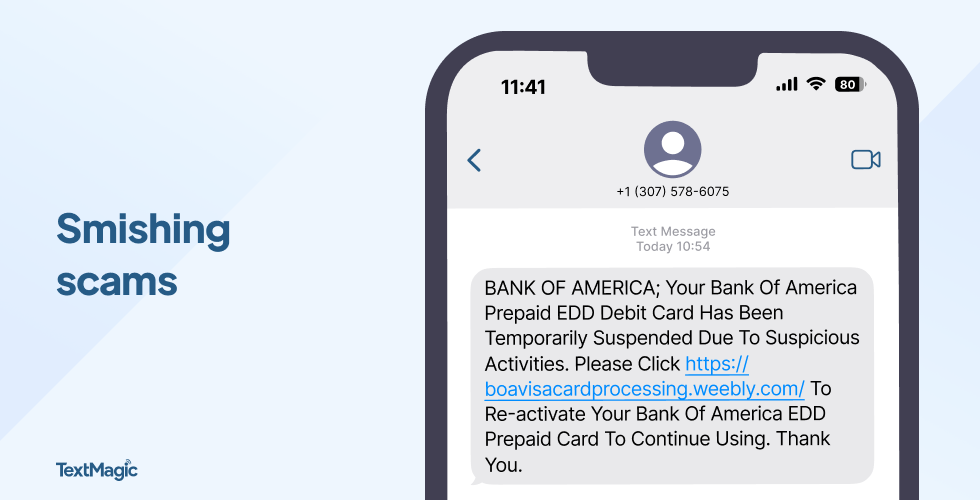
SMS phishing scams (smishing) are fraudulent and deceptive messages sent via SMS to trick recipients into divulging sensitive personal information, financial details, or clicking on malicious links. These messages often impersonate legitimate entities, such as banks or government agencies, aiming to steal data, credentials, or money through manipulated text communications.
Smishing attacks exploit the immediacy of text messages to exploit recipients’ trust and prompt them to take actions that benefit the attackers. Scammers do this by including specific features of companies or products you know in their text messages so you don’t have to doubt their authenticity but do their bidding.
Furthermore, they are accompanied by a sense of urgency, persuading you to click on malicious links and share sensitive information. So, whenever you receive any message that resembles the one in the image above, it is most likely a SMS scam.
2. Tax refund scams

In this type of scam, fraudsters pose as government agencies like the IRS and send text messages to individuals, claiming that they are eligible for a tax refund. The message often includes enticing phrases like “You are owed a tax refund” or “Claim your refund now”. To proceed, recipients are typically instructed to click on a link or reply to the message.
Once recipients engage, scammers may request sensitive personal information, such as Social Security numbers, bank account details, or credit card information, under the guise of verifying their identity for the refund process. Alternatively, they might demand a processing fee upfront before the supposed refund can be released.
These tactics play on recipients’ desire to receive a refund and their trust in government agencies, making them more susceptible to sharing confidential information or making payments. It’s important to remember that legitimate government agencies would never request sensitive information or fees through unsolicited text messages. To stay safe, you should avoid clicking on links, sharing personal information, or making any payments in response to such messages.
3. Prize and lottery scams

Prize and lottery scam messages make you believe you have won a contest or lottery, then demand that you pay or provide your data to claim your winnings. Scammers understand the excitement of randomly winning a prize. Hence, they use it to lure you into their trap with fake winning notifications.
4. Fake package delivery scams

Like SMS spoofing, this type of scam text message is used to impersonate reputable companies like Amazon and USPS. They claim to have your package and may ask you to provide specific details to prove ownership or resend a delivery code sent to your device. Other times, they may ask you to click a link to track or reschedule your delivery that was halted due to some issues.
5. Financial scams

Scammers are leveraging the financial prosperity trend to rip people off their hard-earned money via SMS. They promise substantial—albeit fraudulent—investment opportunities, enticing recipients with returns that are, in reality, too good to be true.
They also persuade you to take immediate action, claiming the opportunity is time-sensitive.
Moreover, unlike legit investments, most financial scam messages do not contain credible information and data to assess their validity.
6. Charity scams
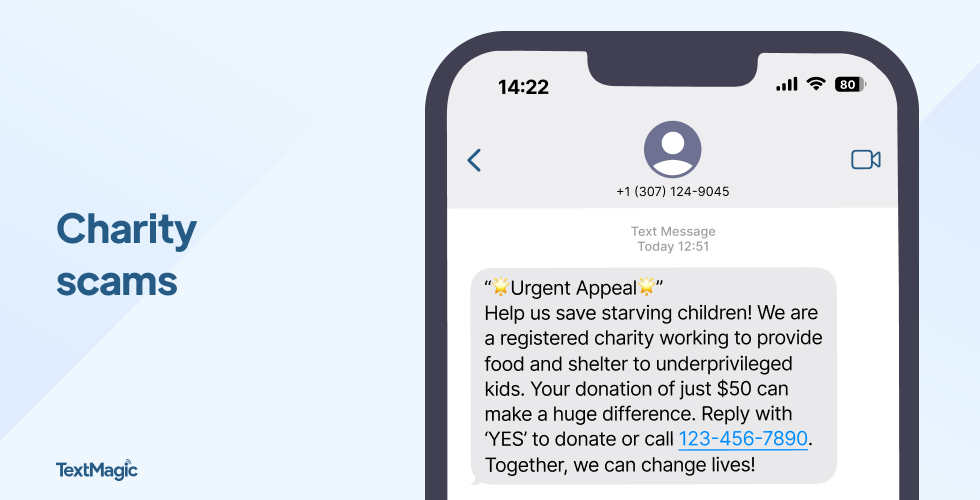
Charity text message scams exploit people’s goodwill. They are often from individuals or groups who pose as legitimate charity organizations to deceive people into donating to their malicious cause.
Scammers using this type of SMS scam may request you directly transfer to a specific account or input your credit card details on their website. Furthermore, charity scam messages are accompanied by emotional blackmail and a tone of urgency and pressure to win your sympathy and prompt you to act swiftly.
7. Job offer scams

The typical job search journey is a wild-goose chase. Scammers know this and use it to exploit job seekers, especially since many are desperate for a job. Many scam job-offer messages trick you into paying a specific amount to land a job.
They may also persuade you to contact a number, click a link to accept a job offer, or read about their other employment opportunities. At first glance, it may seem harmless, but it is most likely a scam job. Authentic recruiters will not request money or ask you to click a link to land a job.
8. Romance scams
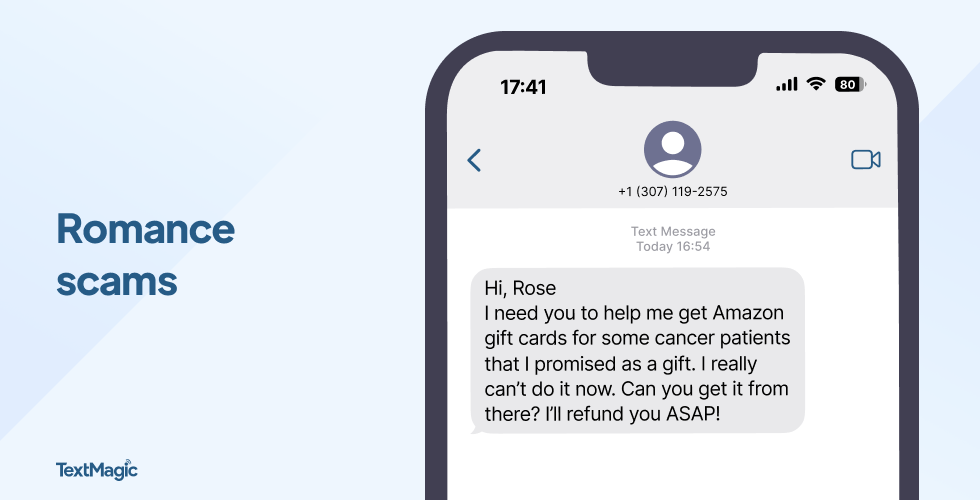
This is one of the popular SMS scams that is difficult to identify due to the peculiarity of the subject matters – love and companionship. Fake romance messages are often accompanied by guilt, emotional blackmail, and fear. Here, scammers create fake online personas as potential love interests to manipulate and exploit unsuspecting people emotionally and financially.
Also, as you progress into the conversation, they may seek financial assistance through wire transfers, gift cards, or online payments. They might even promise to repay the money, creating false hope.
9. Government impersonation
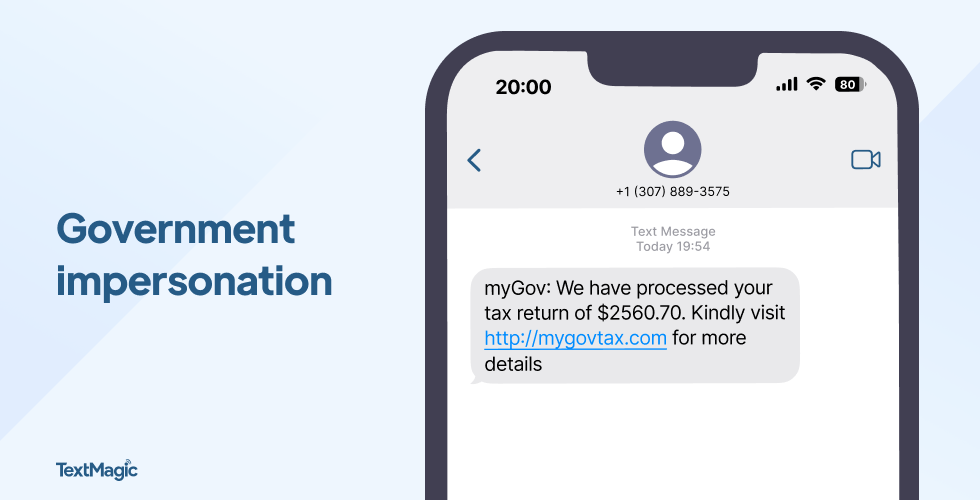
Government impersonation is an SMS scam where cyberattackers send fraudulent text messages pretending to be government officials or agencies. They use an official tone, logo, and language to appear legitimate. Furthermore, these messages are designed to deceive you into clicking a link or sharing sensitive personal information.
The goal is to exploit individuals’ trust in government entities and extract sensitive information or money for illicit purposes.
10. Tech support scams
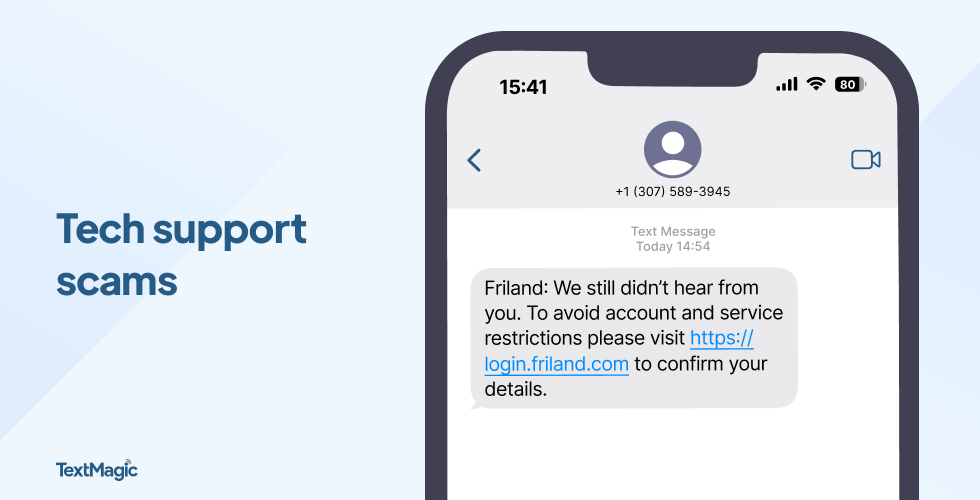
This SMS scam is a cybercrime where scammers pretend to be real tech support representatives from well-known companies. They highlight a problem, offer unsolicited support, and create a sense of fear and urgency so you can respond almost immediately. They may also use real technical terms and provide case numbers and IDs to appear more legitimate.
In addition, as you engage them, they may guide you into providing them with remote access to your device. One way to do that is to persuade you to download a tool they can use to steal your personal and financial information.
How to identify scam text messages
Irrespective of how real they may appear, it is possible to identify scam text messages. Here are a few ways or signs to look out for to know a text message is fraudulent:
1. Unexpected messages from unknown numbers
Scam texts are often from unknown numbers not in your contact list. Sometimes, they don’t correspond with your country’s mobile number code. The reason is that scammers like to remain anonymous to avoid identification.
By using unknown numbers, you won’t be able to trace their messages to a particular individual or organization. As such, any text message sent out of the blue from an unknown number is most likely from scammers.
2. Urgent or threatening language
Scammers seldom have the patience to carry out their malicious activities because they fear being caught. Thus, their messages always have a tone of urgency and pressure. They try not to give you time to think, cross-check the message content, or ask relevant questions before taking necessary actions.
3. Misspellings, grammatical errors, or suspicious links
In a bid to mimic the real ones, most scammers often end up misplacing words and punctuation. They also misuse capitalization, especially for names and common nouns. Furthermore, most scam text messages use short or broken, incoherent links. Some of them also have extra words and misspellings. For example, apetworld.com may appear as apettworld.com
4. Requests for personal or financial information
Reputable organizations have sophisticated databases, portals, and systems for securely collecting and storing customer information. Consequently, they do not need to request your social security number, passwords, or credit card information via SMS. Thus, pay no attention to messages requesting your personal or financial information, sensitive or not.
5. Unsolicited requests for payment or donations
Genuine charitable organizations prioritize ethical fundraising practices and maintain decorum when approaching donors via SMS or other means. That is, they do not initiate requests for payment or donations to individuals who have not permitted them to contact them. So any unsolicited request to donate to a charity project via SMS indicates potential fraudulent activity.
Drawing the line: SMS scams vs. SMS spam
While both unwanted, there’s a crucial distinction between SMS scams and SMS spam that users should recognize. SMS scams, particularly smishing, are deceptive maneuvers with malicious intent. They aim to trick recipients into divulging sensitive information, posing a significant threat to personal security and privacy. For instance, a scam text might pose as a bank, prompting the recipient to verify their account details through a fraudulent link.
In contrast, SMS spam refers to bulk, unsolicited messages that promote products or services. To help users distinguish between malicious content and unwanted advertisements, a variety of spam text messages examples are provided on cybersecurity websites and platforms. For instance – receiving a text message promoting a sale at a store you’ve never shopped at or announcing you’ve won a contest you never entered. While spam messages can be annoying and potentially incur charges, they are not inherently malicious.
Understanding the difference between SMS scams and SMS spam is vital, as it informs the appropriate response—whether actively protecting oneself against a potential security breach or simply deleting an unwanted promotional message.
Tips to protect yourself from SMS scams
As scammers devise increasingly sophisticated tactics, it’s crucial to arm yourself with knowledge and awareness to avoid falling victim.
Below are some surefire tips to protect yourself from scam text messages:
- Never click on links from unknown sources until you have confirmed their authenticity.
- Exercise restraint and caution when providing your personal information.
- Verify requests through official channels before taking any action.
- Install security software from a reputable site and update your devices regularly.
- Clear your browsing history, downloads, and cache to remove any malware that may have entered your phone while you surfed the web.
- Use tools like https://haveibeenpwned.com/ to identify, thwart, and sidestep SMS scams, preserving your personal and financial security.
Reporting text messaging scams
Here are three effective ways to report scam text messages when you receive one:
- Contact your mobile carrier: Email, text, or call your mobile network carrier, informing them of every scam message you receive.
- Report scams to regulatory authorities: In the UK, you can report to Action Fraud. Conversely, you can submit a report in the US via the FTC Complaints page.
- Forward scam messages to anti-fraud organizations: Forward all scam text messages to 7726, available for all mobile operators in the UK and the US, except Vodafone, which uses 87726.
Stay vigilant
As the digital space keeps expanding, scammers will continue to use scam text messages to exploit people’s ignorance and vulnerability. Hence, you must stay vigilant and protect yourself. Furthermore, as a business owner, you are not exempted—endeavor to prioritize your customers’ safety. Your bulk messages may come off as SMS phishing scams to most people, irrespective of your genuineness.
Therefore, activating our SMS STOP Command is essential to enable customers to opt out of your SMS list anytime. This saves your company money and potentially its reputation too.
Related articles
Successfully outsource customer service using 8 tips we tested ourselves
Poor customer service impairs user experience and un...
How to use an employee text messaging system for internal staff communication
As traditional companies gradually get replaced by b...
5 Ways to get the most out of your Textmagic trial
Not sure if business texting is right for you? Sign ...
10 Best customer service books to read in 2025
Creating the best customer experience starts and end...
Upgrading your text messaging with an SMS autoresponder
SMS autoresponders are a company’s best option for o...




